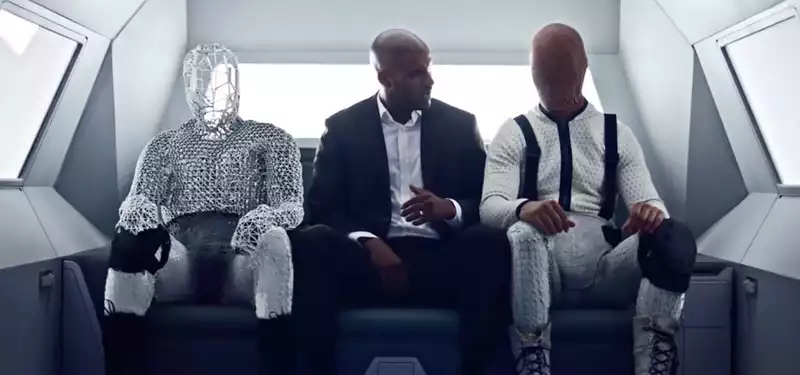May 1, 2017
Step by Step: How was the disturbing godly body scene in "American Gods" created?
There was plenty of striking imagery at yesterday's series premiere of Starz's "American Gods," an adaptation of Neil Gaiman's novel.
The show's producers call this stylistic approach "Godflesh. Thrust into a world of old gods versus new gods, the main character Shadow Moon (Ricky Whittle) witnesses these human-like beings with very different skin and body surfaces.
Visual effects played a major role in bringing Godfish's appearance to life with a custom-built camera rig and a mix of photogrammetry and 3D animation techniques by visual effects studio BUF. Cartoon Brew asked the visual effects team of "American Gods" members about how Godflesh was created step-by-step.
The idea behind Godflesh was to represent all of the "majesty" of the gods. Shadow sees them for the first time when he meets the new god Technical Boy (Bruce Langley). The flesh of these gods dissolves into a variety of cables, wires, and pieces of flesh, but they still take on human form.
This meant that the visual effects crew had to find a way to acquire a performance that was representative of the actor's entire body, not just motion capture. The acquired performances could then be used to "re-skin" the actors.
"Basically, the normal production process dictated that we acquire volumetric performance captures on set," explains visual effects designer Kevin Todd Haug.
"In other words, it was to make the production as light as possible so that when the scene came on, we could slide in some sort of rigging, capture the volume in the same lighting, and get out of it."
Many different setups were tested to study how to capture this volumetric data. Initially, a rig with 20 cameras in stereo pairs was tried, but it proved difficult to synchronize so many cameras. Eventually, a rig with five to seven digital cameras was devised. It consisted of a main ARRI Alexa camera and a small URSA Mini camera from Blackmagic Design.
In short, "American Gods," like other television productions, was shot at high speed, so it was important to be nimble. Visual effects cinematographer David Stamp stated, "These URSA cameras were so easy to synchronize, light, portable, and flexible that we could fly in on a moment's notice, build an array, shoot it, and then cut it loose in a live-action scenario."
On set, the actors were filmed playing their roles. Initially, the system was imagined without tracking markers placed on the actors' faces and bodies, but some markers were eventually added to accommodate difficult lighting conditions and to facilitate tracking of the CG animation.
The BUF in Paris then imported the footage captured by the camera rig. Their task was to extract the performance capture and re-skin it to the Godflesh look, utilizing multiple angles of the actors. This was, in effect, a photogrammetric (using multiple photographs to build the 3D model and textures) solution. In this case, however, it was a kind of "photogrammetry in motion."
"BUF is really good at dealing with certain types of photogrammetry," said Mr. Krishnamoorthy. They are sort of the inventors of photogrammetry as a computer graphics technique in our business." [BUF worked with Haug on the groundbreaking photogrammetric effects in "Fight Club."]
"Compared to regular motion capture, BUF does not just generate an animated skeleton and apply it to a model. Instead, it generates a voluminous 3D image that looks like a mass of pixels at a speed of 24 frames per second. It is like a moving sculpture. "
In fact, the visual effects team thought of it more like a three-dimensional voxel than a pixel. They even named the technique "Sladder" after the director, David Slade.
As a result, BUF was able to use Sladar to move different kinds of animated "skins" of wire mesh-like gods. It was something that could be controlled with a high degree of precision from the vast amount of data at the studio's disposal.
And Haug believes that there is much more that can be done with this system.
"I must say that we have touched about two percent of that potential."
.



Post your comment